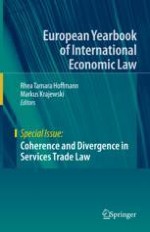2020 | OriginalPaper | Buchkapitel
Upping the Ante: The Movement of Natural Persons (Mode 4) and Non-Services Migration in EU and Asian PTAs
verfasst von : Marion Panizzon, Harjodh Singh
Erschienen in: Coherence and Divergence in Services Trade Law
Aktivieren Sie unsere intelligente Suche, um passende Fachinhalte oder Patente zu finden.
Wählen Sie Textabschnitte aus um mit Künstlicher Intelligenz passenden Patente zu finden. powered by
Markieren Sie Textabschnitte, um KI-gestützt weitere passende Inhalte zu finden. powered by
